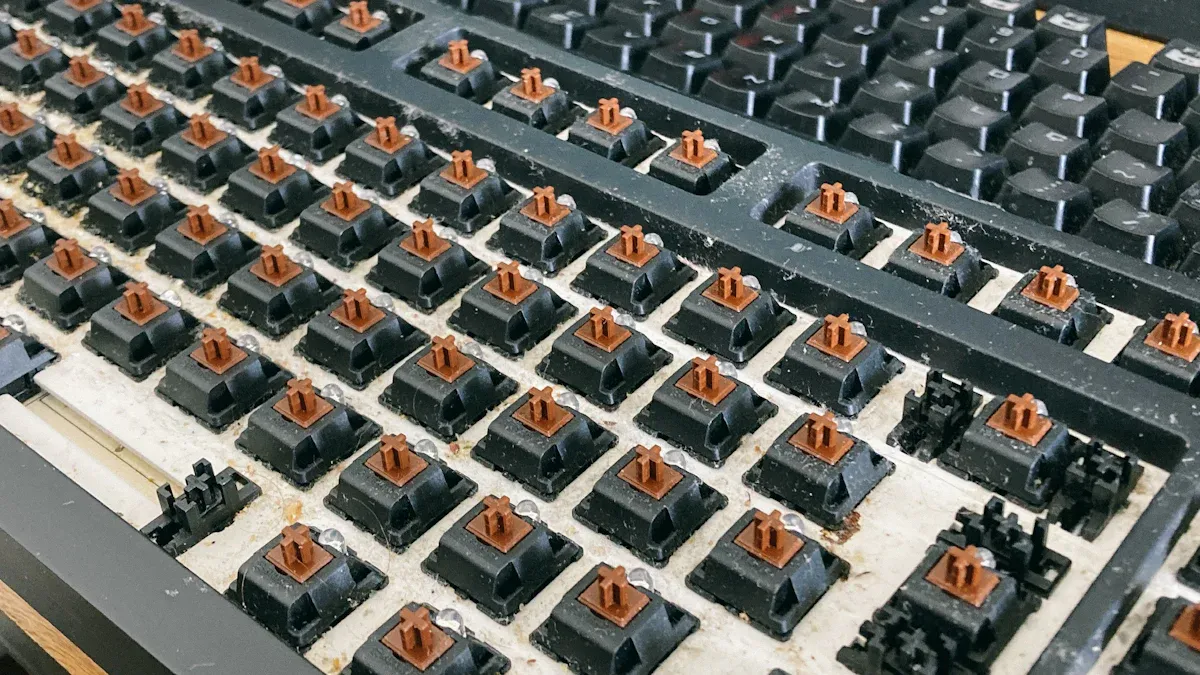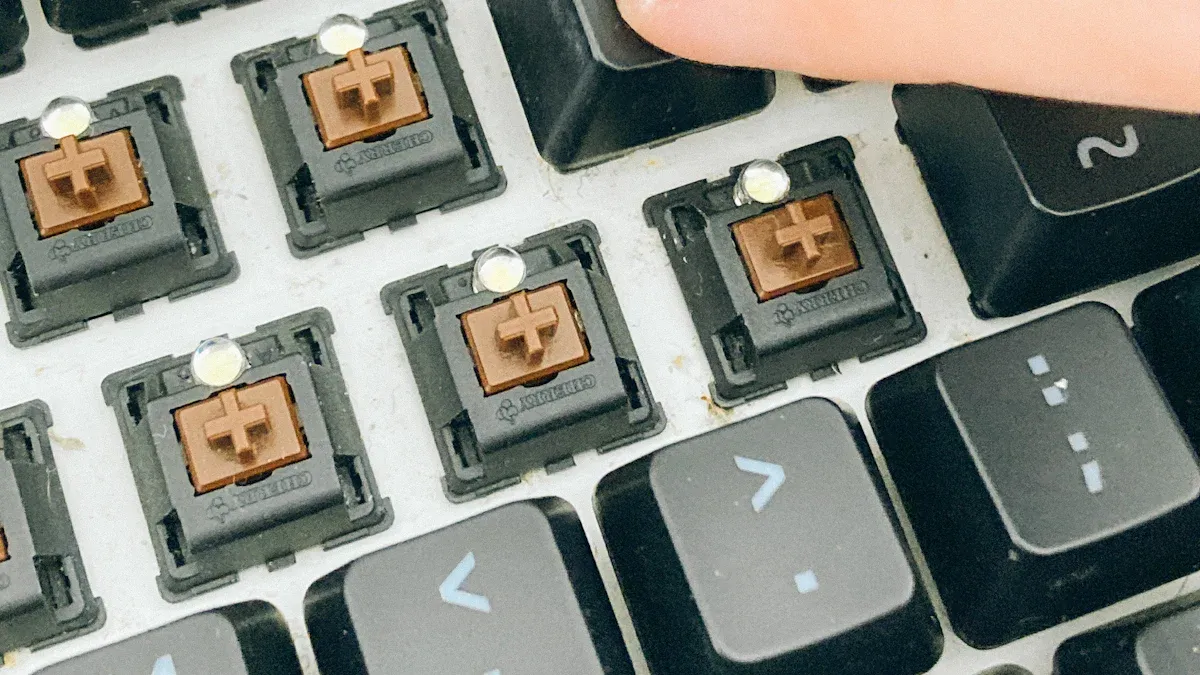
Proper maintenance is essential for keeping your industrial LED backlight keypad functioning efficiently. Regular cleaning helps eliminate dirt that can impact its performance, while protective measures guard against damage in tough environments. Troubleshooting allows for swift resolution of common problems. Whether you’re using a 12 keys industrial outdoor keypad or a brushed industrial 16 keys metal keypad, consistent upkeep guarantees dependable operation.
Key Takeaways
- Clean your keypad often with a soft cloth and rubbing alcohol to stop dirt and keep it working well.
- Keep your keypad safe from damage by using a strong cover and storing it in a safe place.
- Check your keypad every month and fix problems quickly to make it last longer.
Cleaning Your Industrial LED Backlit Keypad

Keeping your industrial LED backlit keypad clean is essential for maintaining its performance and longevity. Dirt, dust, and grime can accumulate over time, leading to unresponsive keys or dim backlighting. By following the right cleaning practices, you can ensure your keypad remains in top condition.
Choosing the Right Cleaning Tools
Using the correct tools is the first step in cleaning your industrial LED backlit keypad effectively. Avoid harsh chemicals or abrasive materials that could damage the keypad’s surface or internal components. Instead, gather the following items:
- A soft microfiber cloth for wiping away dust and smudges.
- Isopropyl alcohol (70% concentration) for disinfecting and removing stubborn grime.
- Cotton swabs for cleaning hard-to-reach areas between the keys.
- Compressed air to blow out debris from crevices.
Tip: Always check the manufacturer’s guidelines before using any cleaning product to ensure compatibility with your keypad.
Step-by-Step Cleaning Instructions
Follow these steps to clean your industrial LED backlit keypad safely and thoroughly:
- Power Off the Keypad: Disconnect the keypad from its power source to avoid accidental damage or electrical hazards.
- Dust the Surface: Use a microfiber cloth to gently wipe the keypad, removing loose dust and dirt.
- Clean Between the Keys: Dip a cotton swab in isopropyl alcohol and carefully clean the spaces between the keys. This helps remove grime that may affect key responsiveness.
- Disinfect the Surface: Lightly dampen the microfiber cloth with isopropyl alcohol and wipe the entire keypad surface. Avoid soaking the cloth to prevent liquid from seeping into the keypad.
- Dry Thoroughly: Allow the keypad to air dry completely before reconnecting it to the power source.
Note: If your keypad has a protective cover, clean it separately using the same steps.
Mistakes to Avoid During Cleaning
Avoiding common mistakes can prevent accidental damage to your industrial LED backlit keypad:
- Using Excessive Liquid: Never pour cleaning solutions directly onto the keypad. Excess moisture can seep into the device and cause electrical issues.
- Applying Too Much Pressure: Pressing too hard while cleaning can damage the keys or the backlighting system. Use a gentle touch.
- Skipping Regular Cleaning: Allowing dirt to build up over time can lead to more severe problems, such as stuck keys or malfunctioning LEDs.
Warning: Do not use abrasive materials like steel wool or harsh chemicals like bleach. These can scratch the surface or corrode the keypad’s components.
By using the right tools, following proper cleaning steps, and avoiding common mistakes, you can keep your industrial LED backlit keypad functioning perfectly.
Protecting Your Industrial LED Backlit Keypad

Preventing Physical and Environmental Damage
Protecting your industrial LED backlit keypad from physical and environmental damage is crucial for its longevity. Physical impacts, such as drops or heavy pressure, can harm the keys or internal circuits. Environmental factors like moisture, dust, and extreme temperatures can also degrade its performance. To prevent these issues, handle the keypad with care and avoid placing heavy objects on it. Store it in a dry, temperature-controlled area when not in use. If your keypad operates in a high-risk environment, consider additional protective measures to shield it from potential hazards.
Benefits of Using Protective Covers
A protective cover acts as a barrier between your keypad and external threats. It prevents dust and debris from settling into the spaces between the keys, reducing the risk of malfunction. Covers also protect against accidental spills, which can cause electrical damage. Many covers are designed to withstand harsh conditions, making them ideal for industrial settings. By investing in a durable cover, you can extend the life of your keypad and reduce the need for frequent repairs.
Best Practices for Harsh Environments
Industrial environments often expose keypads to extreme conditions. To ensure your industrial LED backlit keypad performs reliably, follow these best practices:
- Use a waterproof or weather-resistant model if moisture is a concern.
- Regularly inspect the keypad for signs of wear or damage.
- Install the keypad in a location that minimizes exposure to direct sunlight or heavy vibrations.
- Pair the keypad with compatible accessories, such as enclosures or mounting brackets, for added protection.
By implementing these strategies, you can safeguard your keypad and maintain its functionality even in the toughest conditions.
Troubleshooting Your Industrial LED Backlit Keypad
Even with regular maintenance, your industrial LED backlit keypad may occasionally encounter issues. Troubleshooting these problems promptly can save you time and prevent further damage. Below are common issues and practical solutions to keep your keypad functioning optimally.
Diagnosing Unresponsive Keys
Unresponsive keys can disrupt operations and slow down productivity. Identifying the root cause is the first step toward resolving the issue.
- Check for Dirt or Debris: Dust or grime trapped under the keys often causes them to stop working. Inspect the keypad closely and clean it using a cotton swab dipped in isopropyl alcohol.
- Inspect for Physical Damage: Look for cracks, dents, or other visible damage. Physical impacts can misalign or break internal components.
- Test the Connection: If the keypad is connected to a device, ensure the cable or wireless connection is secure. Loose connections can lead to unresponsive keys.
- Perform a Reset: Disconnect the keypad from its power source for a few minutes, then reconnect it. This simple step can resolve minor software glitches.
Tip: If only specific keys are unresponsive, the issue may be isolated to those keys. Focus your cleaning and inspection efforts on the affected areas.
Fixing LED Backlight Issues
The LED backlighting in your keypad enhances visibility, especially in low-light environments. If the backlight stops working, follow these steps to troubleshoot:
- Verify the Power Supply: Ensure the keypad is receiving adequate power. A weak or unstable power source can cause the backlight to flicker or fail.
- Adjust the Brightness Settings: Some keypads allow you to control the brightness of the backlight. Check the user manual to see if the settings need adjustment.
- Inspect for Loose Connections: Open the keypad (if the design permits) and check for loose or disconnected wires leading to the LED system.
- Look for Burnt-Out LEDs: Over time, individual LEDs may burn out. If this happens, you may need to replace the faulty LEDs or the entire backlight module.
Warning: Avoid attempting internal repairs unless you have the necessary expertise. Mishandling the components can void the warranty or cause further damage.
When to Call a Professional
Some issues require professional assistance to ensure proper resolution. Knowing when to seek help can save you from costly mistakes.
- Persistent Problems: If cleaning, resetting, or basic troubleshooting doesn’t resolve the issue, consult a technician.
- Internal Component Damage: For problems involving internal circuits, wiring, or LED modules, professional repair is often the safest option.
- Warranty Coverage: If your keypad is still under warranty, contact the manufacturer or an authorized service center for repairs. Attempting to fix it yourself may void the warranty.
Note: Always choose a technician experienced in industrial equipment to ensure your keypad receives the best care.
By diagnosing issues early, addressing backlight problems, and knowing when to call a professional, you can keep your industrial LED backlit keypad running smoothly.
Extending the Lifespan of Your Industrial LED Backlit Keypad
Establishing a Maintenance Routine
A consistent maintenance routine keeps your keypad in excellent condition. Start by scheduling regular cleaning sessions to remove dirt and debris. Inspect the keypad monthly for signs of wear or damage. Check the LED backlighting and test all keys to ensure they respond correctly. If you notice any issues, address them immediately to prevent further complications.
Tip: Create a checklist for your maintenance routine. This helps you stay organized and ensures no steps are missed.
Proper Usage to Minimize Wear and Tear
Using your keypad correctly reduces unnecessary strain on its components. Avoid pressing the keys too hard, as this can damage the internal mechanisms. Keep liquids away from the keypad to prevent spills that could harm the electronics. If your keypad is portable, handle it gently and avoid dropping it.
- Place the keypad in a stable location to prevent accidental falls.
- Use the keypad only for its intended purpose to avoid overloading its system.
Note: Proper usage not only minimizes wear but also enhances the overall performance of your Industrial LED Backlit Keypad.
Upgrading Components for Longevity
Upgrading certain parts of your keypad can extend its lifespan significantly. Replace worn-out keys or damaged LED modules with high-quality replacements. If your keypad operates in a demanding environment, consider upgrading to a more durable model with enhanced features like waterproofing or shock resistance.
Warning: Always use compatible components for upgrades. Incompatible parts can cause malfunctions or void the warranty.
By establishing a maintenance routine, using the keypad properly, and upgrading components when necessary, you can maximize the lifespan of your Industrial LED Backlit Keypad.
Maintaining your industrial LED backlit keypad ensures it performs reliably over time. Regular cleaning, proper protection, and quick troubleshooting save you money and reduce downtime. These practices also extend the keypad’s lifespan. By investing in consistent care, you enhance the efficiency and reliability of your equipment in demanding environments.
FAQ
What should you do if your keypad gets wet?
- Power off the keypad immediately.
- Dry it with a soft cloth.
- Let it air dry completely before use.
Tip: Avoid using heat sources like hair dryers to prevent internal damage.
How often should you clean your industrial LED backlit keypad?
Clean your keypad at least once a month. If used in dusty or high-traffic environments, increase the frequency to every two weeks for optimal performance.
Can you replace the LED backlight yourself?
Yes, but only if you have technical expertise. Otherwise, consult a professional to avoid damaging the keypad or voiding its warranty.
Warning: Mishandling internal components can lead to permanent damage.


